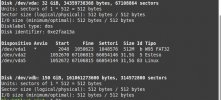Hi,
I created a ZFS pool, set one dataset for my VM to run, then I created a new dataset to put in it some data and set for it a quotas too.
So, I restored my VMs in lukepool/vmstorage. So far so good.
Next, I wanted to create a disk for my linux VM machine
SO, first datacenter->add:zfs. I picked my dataset
it created another storage (called disk_mint)
then, in my linux vm setup I added a disk and picked that storage
it worked. I see it in my linux vm's shell now.
Fdisk -l

another screen:

Hard disk: disk_mint is the disk I add out of my 250GB dataset storage
here are a few issues though.
My dataset (lukepool/share) has 250GB as quotas
I would assign tehe entire size to my new linux vm's HDD
But I could only set much less than that, only 150 GB
my updated zfs list:
Not sure what this line lukepool/share 205G 45.3G 128K /lukepool/share means exactly.
Your thoughts, please.
Thanks
I created a ZFS pool, set one dataset for my VM to run, then I created a new dataset to put in it some data and set for it a quotas too.
So, I restored my VMs in lukepool/vmstorage. So far so good.
Next, I wanted to create a disk for my linux VM machine
SO, first datacenter->add:zfs. I picked my dataset
it created another storage (called disk_mint)
then, in my linux vm setup I added a disk and picked that storage
it worked. I see it in my linux vm's shell now.
Fdisk -l

another screen:

Hard disk: disk_mint is the disk I add out of my 250GB dataset storage
here are a few issues though.
My dataset (lukepool/share) has 250GB as quotas
I would assign tehe entire size to my new linux vm's HDD
But I could only set much less than that, only 150 GB
my updated zfs list:
Code:
root@pve:~# zfs list
NAME USED AVAIL REFER MOUNTPOINT
lukepool 277G 621G 128K /lukepool
lukepool/share 205G 45.3G 128K /lukepool/share
lukepool/share/vm-103-disk-0 205G 250G 74.6K -
lukepool/vmstorage 72.4G 621G 128K /lukepool/vmstorage
lukepool/vmstorage/vm-101-disk-0 34.6G 621G 34.6G -
lukepool/vmstorage/vm-102-disk-0 1.26G 621G 1.26G -
lukepool/vmstorage/vm-103-disk-0 36.5G 621G 36.5G -Not sure what this line lukepool/share 205G 45.3G 128K /lukepool/share means exactly.
Your thoughts, please.
Thanks
Last edited:

